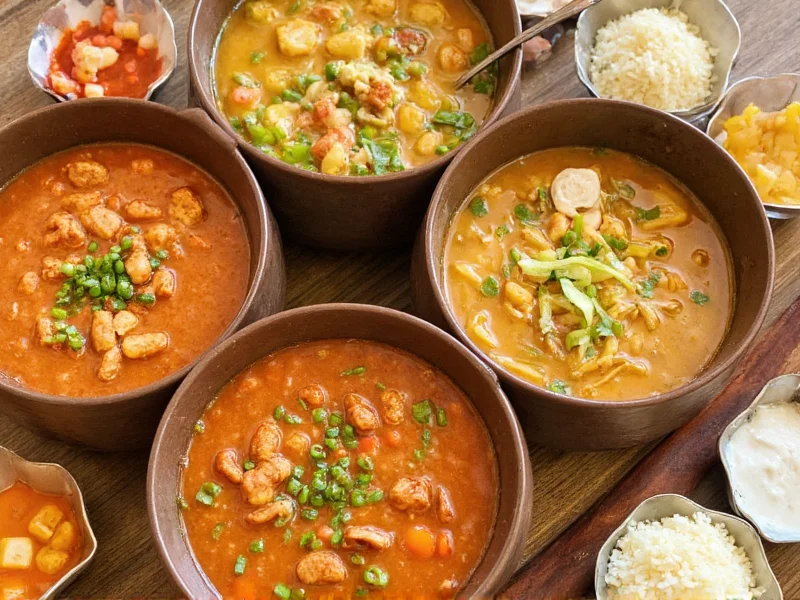Soup represents one of humanity's oldest culinary inventions, with evidence of soup-making dating back 20,000 years. Understanding the different types of soup provides valuable insight into global culinary traditions and practical meal planning. This comprehensive guide explores soup varieties through multiple classification systems, helping home cooks and food enthusiasts navigate the diverse world of soups.
Understanding Soup Classification Systems
Professional chefs and culinary historians typically categorize soups using several complementary systems rather than a single rigid structure. The most practical approach considers both preparation method and cultural origin, allowing for meaningful comparisons across global traditions.
Main Categories of Soup
Clear Soups
Clear soups feature transparent broth as their foundation, achieved through careful clarification processes. These traditional soup varieties emphasize pure flavors and delicate textures.
- Bouillon - Simple meat or vegetable broth, often used as a base for other soups
- Broth - Similar to bouillon but typically contains small pieces of meat or vegetables
- Consommé - Highly refined clear soup clarified using egg whites and minced meat
- Stock - Flavorful liquid made by simmering bones, used as cooking foundation
Thick Soups
Thick soups create satisfying, substantial meals through various thickening methods. Understanding soup base types helps identify authentic preparations versus modern adaptations.
| Type | Thickening Method | Signature Examples |
|---|---|---|
| Puree | Blended main ingredients | French pea soup, Spanish gazpacho |
| Cream | Dairy or coconut milk | Cream of mushroom, tomato bisque |
| Velouté | Roux with stock | Chicken velouté, seafood bisque |
| Bisque | Heavy cream with shellfish | Lobster bisque, shrimp bisque |
Cold Soups
Perfect for warm climates and summer dining, cold soup recipes offer refreshing alternatives to traditional hot preparations. These specialty soups often feature raw or minimally processed ingredients.
- Gazpacho - Spanish tomato-based soup with vegetables and olive oil
- Vichyssoise - French leek and potato soup served chilled
- Aioli - Catalan garlic soup sometimes served cold
- Shabu-jiru - Japanese cold noodle soup with dipping sauce
Regional Soup Specialties
International soup varieties reflect local ingredients, climate conditions, and cultural traditions. Exploring regional specialties provides insight into authentic culinary practices.
European Soup Traditions
European cuisine features some of the most formally codified soup classifications. French culinary tradition established the classic clear and thick soup categories that influenced Western cooking worldwide. Traditional European soup varieties often incorporate local grains, dairy products, and seasonal vegetables.
- Borscht - Eastern European beet soup, often served with sour cream
- Minestrone - Italian vegetable soup with beans and pasta
- Goulash - Hungarian stew-like soup with paprika and meat
- Cullen Skink - Scottish smoked fish soup with potatoes
Asian Soup Varieties
Asian soup traditions emphasize balance of flavors and medicinal properties. Many traditional Asian soup varieties serve both culinary and therapeutic purposes according to traditional medicine systems.
- Miso soup - Japanese fermented soybean soup with tofu
- Tom Yum - Thai hot and sour shrimp soup with lemongrass
- Pho - Vietnamese noodle soup with aromatic broth
- Hot and sour soup - Chinese vinegar-based soup with mushrooms
American and Latin Variations
The Americas showcase soup traditions blending indigenous, European, and African influences. Regional soup specialties often incorporate local ingredients like corn, beans, and tropical fruits.
- Caldo - Latin American family of broths with regional variations
- Chowder - North American creamy soup, especially clam chowder
- Pozole - Mexican hominy soup with meat and chilies
- Black bean soup - Cuban specialty with citrus garnish
Selecting Soups for Different Needs
Understanding seasonal soup recommendations helps create balanced meal plans throughout the year. Cold soups typically shine in summer months, while hearty thick soups provide comfort during colder seasons. Many traditional soup varieties have evolved specifically for particular climate conditions.
For health-conscious eaters, broth-based soups generally offer lower calorie options compared to cream-based varieties. Vegetarian and vegan adaptations exist for nearly all traditional soup varieties, often substituting plant-based proteins and dairy alternatives.
When exploring international soup varieties, consider starting with milder versions before progressing to more complex or spicy preparations. Many regional soup specialties have authentic versions that differ significantly from Westernized adaptations.











 浙公网安备
33010002000092号
浙公网安备
33010002000092号 浙B2-20120091-4
浙B2-20120091-4